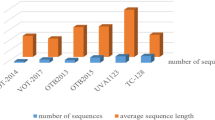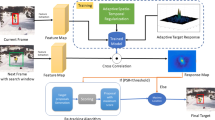Abstract
Taking into account the difficulties of multiple maneuvering target tracking due to the unknown target number and the uncertain acceleration, a novel multiple maneuvering target tracking algorithm based on the Probability Hypothesis Density (PHD) filter and Modified Input Estimation (MIE) technique is proposed in this paper. First, the unknown acceleration vector is added to the target state to form a new augmented state vector. Then, strong tracking filter multiple fading factors are introduced to the MIE method which can adjust the prediction covariance and the corresponding filter gain at different rates in real time, so that the MIE method can adaptively track high maneuvering targets well. Finally, we combine this adaptive MIE method with the PHD filter, which can effectively track multiple maneuvering targets without much prior information. Simulation results show that the proposed algorithm has a higher tracking precision and a better real-time performance than the conventional maneuvering target tracking algorithms.
Similar content being viewed by others
References
T. Fortmann, Y. Bar-Shalom, and M. Scheffe, “Sonar tracking of multiple targets using joint probabilistic data association,” IEEE Journal of Oceanic Engineering, vol. 8, no. 3, pp. 173–184, 1983.
D. Musicki and R. Evans, “Joint integrated probabilistic data association: JIPD,” IEEE Trans. on Aerospace and Electronic System, vol. 40, no. 3, pp. 1093–1099, 2004.
S. Blackman, “Multiple hypothesis tracking for multiple target tracking,” IEEE A&E Systems Magazine, vol. 19, no. 1, pp. 5–18, 2004.
J. Roecker and G. Pillis, “Suboptimal joint probabilistic data association,” IEEE Trans. on Aerospace and Electronic System, vol. 29, no. 2, pp. 504–510, 1993.
J. Roecker, “A class of near optimal JPDA algorithms,” IEEE Trans. on Aerospace and Electronic System, vol. 30, no. 2, pp. 504–510, 1994.
D. Musicki and B. La Scala, “Multi-target tracking in clutter without measurement assignment,” IEEE Trans. on Aerospace and Electronic System, vol. 44, no. 3, pp. 887–896, 2008.
S. Purank and J. K. Tugnait, “Tracking of multiple maneuvering targets using multiscan JPDA and IMM filter,” IEEE Trans. on Aerospace and Electronic System, vol. 43, no. 1, pp. 23–34, 2007.
R. Mahler, “Multitarget Bayes filtering via first-order multitarget moments,” IEEE Trans. on Aerospace and Electronic System, vol. 29, no. 4, pp. 1152–3457, 2003.
B. N. Vo and W. K. Ma, “The Gaussian mixture probability hypothesis density filter,” IEEE Trans. on Signal Processing, vol. 54, no. 11, pp. 4091–4104, 2006.
J. J. Yin, J. Q. Zhang, and Z. S. Zhang, “Gaussian sum PHD filtering algorithm for nonlinear non-Gaussian models,” Chinese Journal of Aeronautics, vol. 21, pp. 341–351, 2008.
M. G. Jin, S. H. Hong, Z. G. Shi, and K. S. Chen, “Current statistical model probability hypothesis density filter for multiple maneuvering targets tracking,” Proc. of the International Conference on Wireless Communication & Signal Processing, pp. 1–5, 2009.
K. Punithakumar and T. Kirubarajan, “Multiplemodel probability hypothesis density filter for tracking maneuvering targets,” IEEE Trans. on Aerospace and Electronic System, vol. 44, no. 1, pp. 87–98, 2008.
S. H. Hong, Z. G. Shi, and K. S. Chen, “Novel multiple-model probability hypothesis density filter for multiple maneuvering targets tracking,” Proc. of the Postgraduate Research in Asia Pacific Conference on Microelectronics & Electronics, pp. 189–192, 2009.
H. Khaloozadeh and A. Karsaz, “Modified input estimation technique for tracking maneuvering targets,” IET Radar, Sonar and Navigation, vol. 3, no. 1, pp. 30–41, 2009.
M. H. Bahari, M. B. Naghibi Sistani, and N. Pariz, “Intelligent fading memory for high maneuvering target tracking,” International Journal of Physical Sciences, vol. 4, no. 10, pp. 548–554, 2009.
M. H. Bahari and N. Pariz, “High maneuvering target tracking using an input estimation technique associated with fuzzy forgetting factor,” Scientific Research and Essays, vol. 4, no. 10, pp. 936–945, 2009.
J. L. Yang and H. B. Ji, “High maneuvering target-tracking based on strong tracking modified input estimation,” Scientific Research and Essays, vol. 5, no. 13, pp. 1683–1689, 2010.
M. Tobias and A. D. Lanterman, “Probability hypothesis density-based multi-target tracking with bistatic range and Doppler observation,” IET Radar, Sonar and Navigation, vol. 152, no. 3, pp. 195–205, 2005.
D. E. Clark and J. Bell, “Multi-target state estimation and track continuity for the particle PHD filter,” IEEE Trans. on Aerospace and Electronic System, vol. 43, no. 4, pp. 1441–1453, 2007.
F. Lian, C. Z. Han, and W. F. Liu, “Estimating Unknown clutter intensity for PHD filter,” IEEE Trans. on Aerospace and Electronic System, vol. 46, no. 4, pp. 2066–2078, 2010.
M. Tobias and A. D. Lanterman, “Techniques for birth-particle placement in the probability hypothesis density particle filter applied to passive radar,” IET Radar, Sonar and Navigation, vol. 2, no. 5, pp. 351–365, 2008.
B. L. Xu, H. G. Xu, and J. H. Zhu, “Ant clustering PHD filter for multiple-target tracking,” Applied Soft Computing, vol. 11, pp. 1074–1086, 2011.
D. H. Zhou and P. M. Frank, “Strong tracking filtering of nonlinear time-varying stochastic systems with colored noise: application to parameter estimation and empirical robustness analysis,” International Journal of Control, vol. 65, no. 2, pp. 295–307, 1996.
D. H. Zhou, “On-line adaptive estimation of time-varying time delay,” Acta Electronica Sinica, vol. 27, no. 12, pp. 61–63, 1999.
D. Schuhmacher, B. T. Vo, and B. N. Vo, “A consistent metric for performance evaluation of multiobject filters,” IEEE Trans. on Signal Processing, vol. 56, no. 8, pp. 3447–3457, 2008.
B. T. Vo, B. N. Vo, and A. Cantoni, “Analytic implementations of the cardinalized probability hypothesis density filter,” IEEE Trans. on Signal Processing, vol. 55, no. 7, pp. 3553–3567, 2007.
D. E. Clark, K. Panta, and B. N. Vo, “Data association and track management for the Gaussian mixture probability hypothesis density filter,” IEEE Trans. on Aerospace and Electronic System, vol. 45, no. 3, pp. 1003–1016, 2009.
E. Pollard, B. Pannetier, and M. Rombaut, “Hybrid algorithm for multitarget tracking using MHT and GM-CPHD,” IEEE Trans. on Aerospace and Electronic System, vol. 47, no. 2, pp. 832–847, 2011.
Author information
Authors and Affiliations
Corresponding author
Additional information
Recommended by Editorial Board member Seul Jung under the direction of Editor Zengqi Sun.
This work was supported by the National Natural Science Foundation of China (No. 60871074).
Jin-Long Yang received his M.S. degree in Circuit and System from Northwest Normal University, China in 2009, and his Ph.D. degree in Pattern Recognition and Intelligent System from Xidian University, China in 2012. He is now an assistant professor of the School of Internet of Things Engineering in Jiangnan University. His research interests include target tracking, information fusion and signal processing.
Hong-Bing Ji received his B.S. degree in Radar Engineering, an M.S. degree in Circuit, Signals and Systems, and a Ph.D. degree in Signal and Information processing, in 1983, 1989 and 1999, respectively, from Xidian University. He is now a professor of the school of Electronic Engineering in Xidian University. His research interests include intelligent information processing, radar targets recognition and classification, weak signal detection and recognition.
Zhen-Hua Fan is currently a Ph.D. candidate at the school of Electronic Engineering, Xidian University. His research interests are target tracking, information fusion and signal processing.
Rights and permissions
About this article
Cite this article
Yang, JL., Ji, HB. & Fan, ZH. Probability hypothesis density filter based on strong tracking MIE for multiple maneuvering target tracking. Int. J. Control Autom. Syst. 11, 306–316 (2013). https://doi.org/10.1007/s12555-012-0032-2
Received:
Revised:
Accepted:
Published:
Issue Date:
DOI: https://doi.org/10.1007/s12555-012-0032-2




